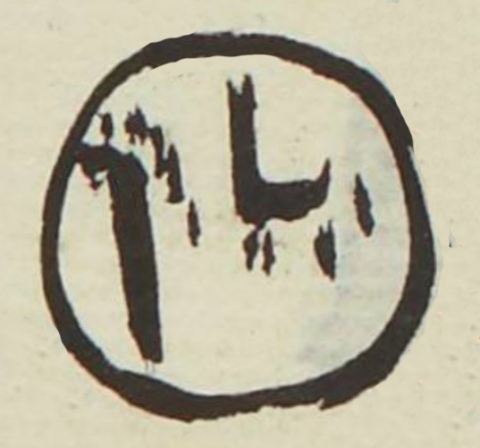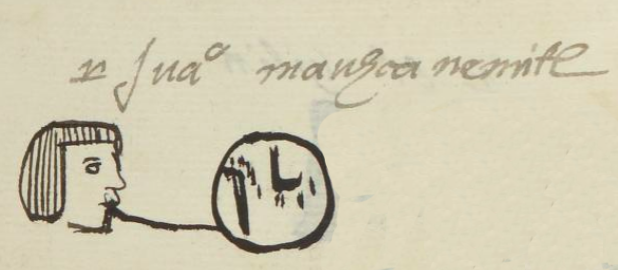Mauhcanemitl (MH523r)
This black-line drawing of the compound glyph of the personal name Mauhcanemitl ("One Who Lives Fearfully") shows two footprints, the one on the left pointed upwards and the one on the right pointed downwards. Both of these footprints are contained inside a circle. The toes are drawn hastily, for the one on the right only has four toe prints. The footprints refer to the verb nemi, to live or go about, which is close to the last part of the name, -nemitl. Nemini is a resident; might nemitl be someone who lives or goes about? The "fearful" part of the name is not shown visually, unless there could be something frightening about the circle.
Stephanie Wood
The fearful element (mauhca) could just possibly be indicated by the ambivalence of the direction of the footprints, or the circle that contains them, perhaps indicating that the person had limited freedom because of the fear--? Footprint glyphs have a wide range of translations. In this collection, so far, we can attest to yauh, xo, pano, -pan, paina, temo, nemi, quetza, otli, iyaquic hualiloti, huallauh, tetepotztoca, totoco, -tihui, and the vowel "o." Other research (Herrera et al, 2005, 64) points to additional terms, including: choloa, tlaloa, totoyoa, eco, aci, quiza, maxalihui, centlacxitl, and xocpalli.
Stephanie Wood
Juo mauhca nemitl
Juan Mauhcanemitl
1560
Stephanie Wood and Daniel Chayet
to go about fearfully, ir con miedo

mauhca, fearfully, https://nahuatl.wired-humanities.org/content/mauhca
nemi, to walk, to go about, https://nahuatl.wired-humanities.org/content/nemi
nemini, a resident, https://nahuatl.wired-humanities.org/content/nemini
El Que Anda con Miedo
Stephanie Wood
Matrícula de Huexotzinco, folio 523r, World Digital Library, https://www.loc.gov/resource/gdcwdl.wdl_15282/?sp=125&st=image.
This manuscript is hosted by the Library of Congress and the World Digital Library; used here with the Creative Commons, “Attribution-NonCommercial-ShareAlike 3.0 License” (CC-BY-NC-SAq 3.0).




